Answered step by step
Verified Expert Solution
Question
1 Approved Answer
1:28:20 How many strongly connected components are there in a complete graph G=(V, E)? Question 1 Not yet answered Marked out of 1.00 P Flag









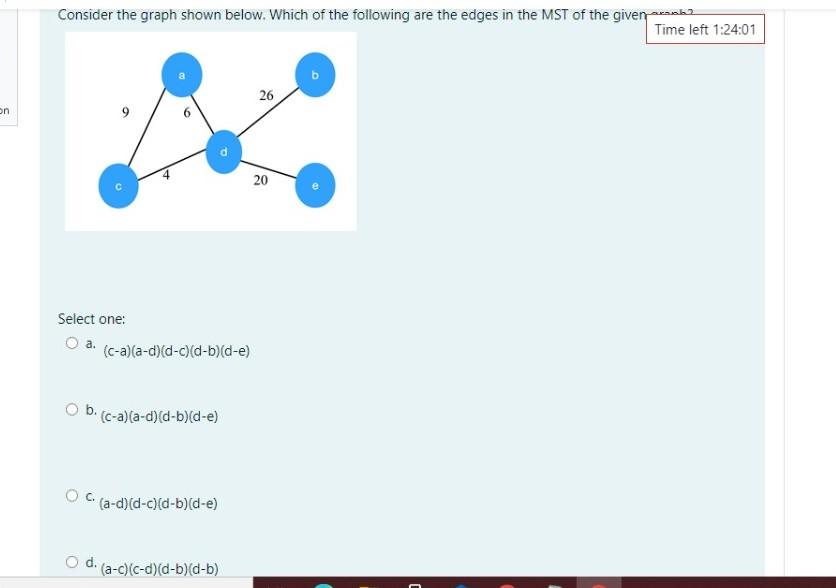





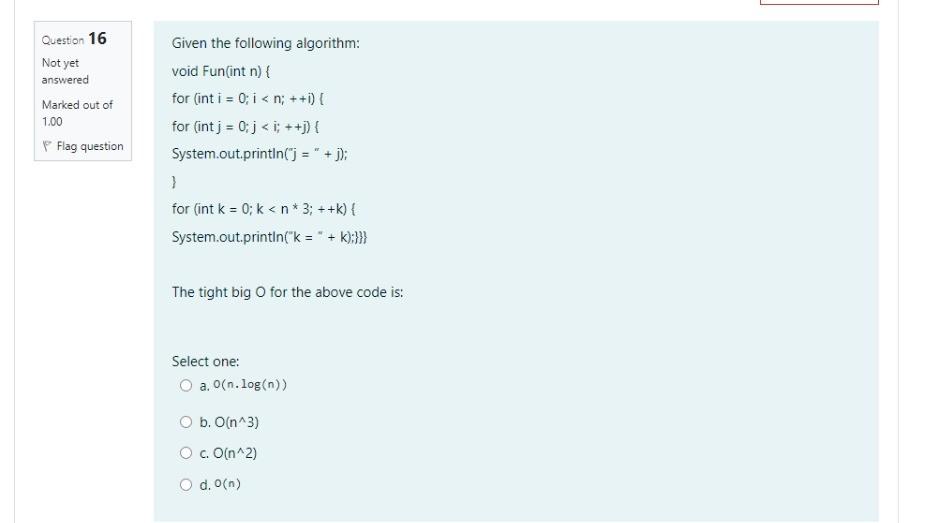
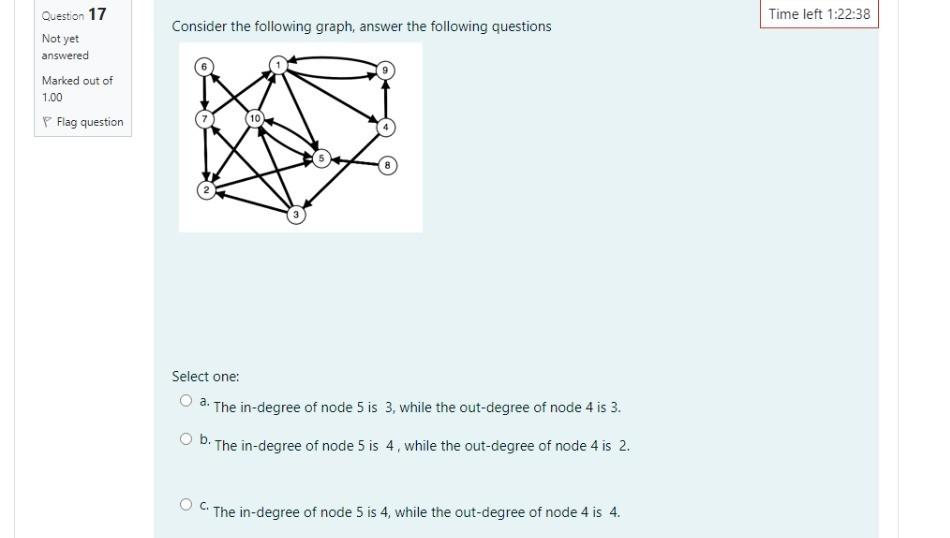

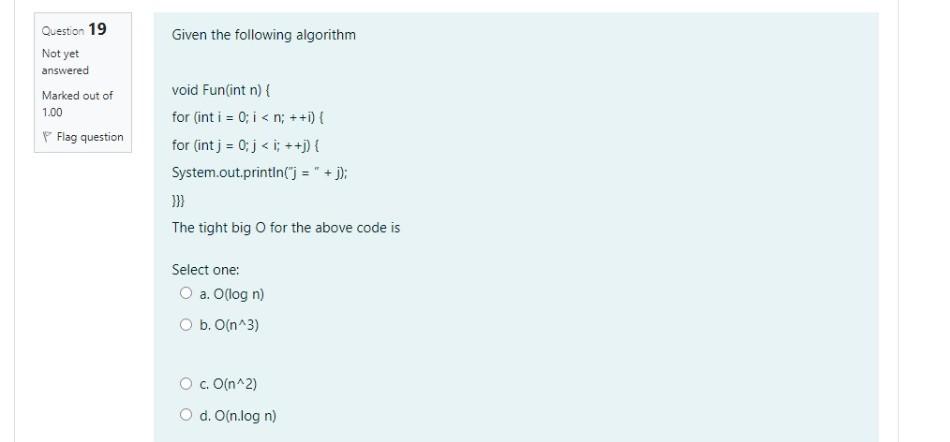

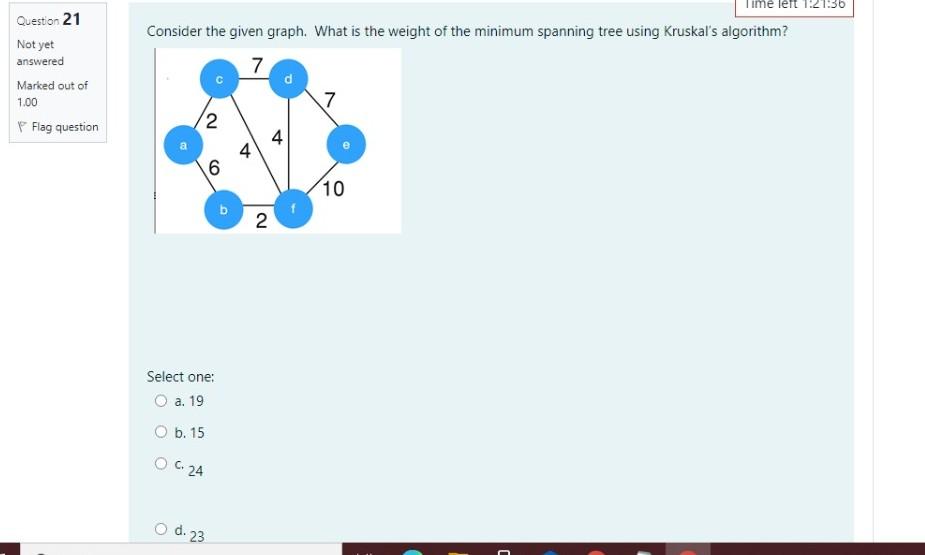




1:28:20 How many strongly connected components are there in a complete graph G=(V, E)? Question 1 Not yet answered Marked out of 1.00 P Flag question Select one: O a. 1 O b. El - 1 O c. MM + IE! O d.MM In a digraph, G=(V. E), the sum of both the in-degrees and out-degrees of all vertices is: Question 2 Not yet answered Marked out of 1.00 P Flag question Select one: a. 211 b. (IVDOVI - 1) O CIEL O d.IV - 1 Oe.M Which element of the following array (15,9,11,2,15,6,7,9,0,11,22] will be chosen as the pivot in the median-of- three rule? Question 3 Not yet answered Marked out of 1.00 P Flag question Select one: O a. 22 O b. 15 O c. 5 O d. 6 Time left 1:24:58 Question 4 Not yet answered Suppose we're debugging a Quicksort implementation that is supposed to sort an array in ascending order. After the first partition step has been completed, the contents of the array are in the following order 13 9 15 14 17 24 22 20). Which of the following statements is correct about the partition step? Marked out of 1.00 Flag question Select one: O a. The pivot could have been 14, but could not have been 17 O b. The pivot could have been 17, but could not have been 14 O c. The pivot could have been either 14 or 17 O d. Neither 14 nor 17 could have been the pivot The solution to the following recurrence T(n)= 27T(n/3) +n^3 using the master theorem is Question 5 Not yet answered Marked out of 1.00 P Flag question Select one: a. O(n^3) O b. On.log n) O c. Master theorem can't be applied Od. O(n^3.log n) Which of the following properties is not true about a simple graph? Question 6 Not yet answered Marked out of 1.00 P Flag question Select one: O a. Must be connected O b. Must have no loops or multiple edges O c. Must be unweighted d. All of the mentioned In binary heaps, the parent of a node in index i (assuming this node has a depth of at least 2) is located at index: Question 7 Not yet answered Marked out of 1.00 Flag question Select one: a. 21 O b.floor(i/2) O c.floor(i/4) O d. None of the above Question 8 Apply Quick sort on a given sequence 7 11 14 6 9 4 3 12. What is the sequence after first phase, pivot is first element? Not yet answered Marked out of 1.00 Flag question Select one: O a. 6 4 3 7 11 9 14 12 O b. 6 3 4 7 9 14 11 12 O c.764 3 9 14 11 12 O d.76 14 11 9 4 3 12 Does the following array represent a max heap? A=[53,14,51,12,13,2,49,13,9,12,10,0,1,48] Question 9 Not yet answered Marked out of 1.00 P Flag question Select one: O a. False O b. True Consider the graph shown below. Which of the following are the edges in the MST of the given sob? Time left 1:24:01 26 on 20 Select one: O a. (c-a)(a-d}(d-c)(d-b)(d-e) O b. (c-a)(a-d)(d-b)(d-e) (a-d)(d-c)(d-b) (de) O d. (a-C)(c-d)(d-b)(d-b) 3 Question 11 Not yet answered Marked out of Given the graph G=(V, E), where V = {0, 1, 2, 3, 4, 5, 6, 7, 8, 9), E = ((3,4), (7,1), (1,6), (1,2), (7,0), (0,4), (2,8), (1,9), (1.4), (5,7), (7,2), (6,4), (6,0)), Which of the following is NOT a correct topological sort? 1.00 Select one: O a. 5, 7, 3, 1, 2, 8, 6, 9, 4, 0 D. 3, 5, 7, 1,6, 0, 4,9 2,8 O b. 3, 5, 7, 1, 2, 6, 0, 4, 9, 8 B. 5, 3, 7, 1,9, 2, 8, 6, 0,4 P Flag question Which case of the master theorem applies to the following recurrence T(n)-4T(n/4) + n2 Question 12 Not yet answered Marked out of 1.00 P Flag question Select one: O a. Case 1 O b. Case 2 c. Master theorem doesn't apply here. O d. Case 3 Question 13 The three partition algorithms studied in class are used with the heapsort algorithm. Not yet answered Marked out of 1.00 Select one: O a. True O b. False Flag question In a heap with n distinct elements and height h, the second largest element has a height of Question 15 Not yet answered Marked out of 1.00 P Flag question Select one: O a. h-2 O bih O c. h-1 O d. 0 Question 16 Not yet answered Marked out of 1.00 P Flag question Given the following algorithm: void Fun(int n) { for (int i = 0; i
Step by Step Solution
There are 3 Steps involved in it
Step: 1

Get Instant Access to Expert-Tailored Solutions
See step-by-step solutions with expert insights and AI powered tools for academic success
Step: 2

Step: 3

Ace Your Homework with AI
Get the answers you need in no time with our AI-driven, step-by-step assistance
Get Started


